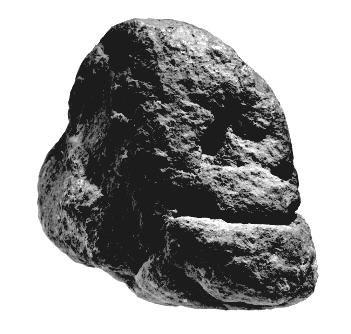
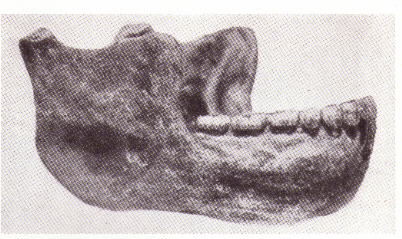
Heidelberg jaw (Euranthropus)
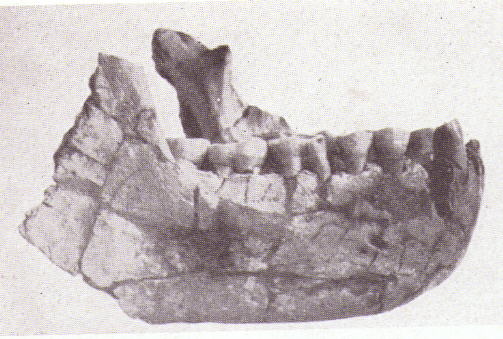
Ternifine jaw (Atlanthropus)
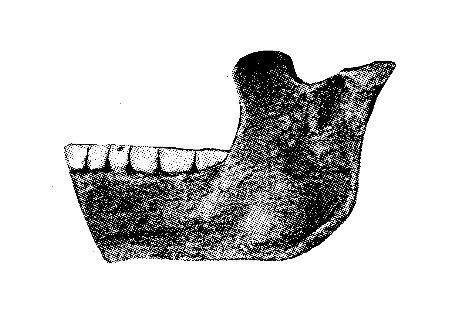
The jaw of Chu-Ku-t' ien (Sinanthropus) Reconstruction from fragments of several jaws of Weidenreich.
1) The burial in sleeping position, 2) the crouching burial, 3) the tool kit, 4) the offering of pieces of meat to the deceased (still intact bovine leg, not fleshed out, as shown by the state of anatomical connection in which the bones were found: La Chapelle - aux - Saints), 5) the offering of flowers and medicinal plants (Shanidar, Iraq).
The first testimony of "sacrifice" is made by Homo sapiens sapiens in the Upper Paleolithic, and is found in the temple of El Juyo in Spain, and dates back to 14,000 years ago.
The "sacrifice" is a ritual, recurrent in all the religions of the world, and in every time, and can be bloody or bloodless.
The "sacrifice" is an offering to enter into communion with the deity.
The temple of El Juyo was a cavern, having an altar composed from a flat slab of sandstone of the weight of approximately one ton: in front of the altar was the effigy of a deity, a lithic sculpture consisting of two half heads joined, one of man and the other of animal. (see in this site : Mexico's ancient zooanthropomorphic ceramics in relation to the european Paleolithic zooanthropomorphic lithic sculpture
The "sacrifice" was probably bloodless, and the remains found are composed by deer phalanges, a lot of ochre, burnt bones, and rests of crustaceans.
I want to underline that the men of El Juyo, who had the temple, the altar formed by a very heavy monolith, purposely brought in the cave, and a two-faced zooanthropomorphic deity represented in sculpture, are to be considered as belonging to a civilization (which doesn't have a name yet), but which must be well distinct from the magdalenian painters' civilization, who were their contemporaries in other European areas.
As we have seen, in the rituals of the Paleolithic the food is recurrent. Homo erectus "ate" the brain of the deceased relative. Homo sapiens neanderthalensis gave food to the deceased. Homo sapiens sapiens, in the "sacrifice", offered food to the deity.
Homo erectus in 350,000 or 500,000 years has changed more times physical aspect, until transform himself, that is to become Homo sapiens sapiens.
The rituals of Homo erectus, known by us, have remained the same until the ethnography of Homo sapiens sapiens, that is today.
It can be said that the spiritual aspects of man are more consistent than his physical aspects, since they change less. However, the spirituality of man becomes richer with cultural progress, and with new religions.
In order to interpret rites, cults and art of the Paleolithic men, we use parallels with post - Paleolithic eras, with historical civilizations and with ethnography. These parallelisms always refer to the people, in fact, the rituals, the "sacrifices", the cults are rooted in the people.
The parallelisms that we make with "living" Homo sapiens sapiens are made not only by what is found in ethnography, but also by what is still found by us modern men, who use mobile and computer.
In ethnography we still find peoples (very small) with rituals, sacrifices, cults and art, remaining intact for millennia. Among us, for example in Europe, what remains, survives in certain areas and not in others, and is generically called "tradition".
These "popular traditions" continue nearly automatically, have lost all religious relevance, but are rich in information for our parallelisms with the Paleolithic.
IMPORTANCE OF FOOD IN RELIGIONS
Muslims are forbidden to eat pork, and to drink alcoholic beverages, always; and in some Islamic nations, this is obligatory by law, even for non-Muslims. Jews are also forbidden to eat pork.
Catholics must not eat meat on Fridays in the days of Lent, i. e., the forty days preceding Easter; fish in these days is preferred.
All the religions have different connections with food.
Catholics eat lamb "roast" at Easter because of "religious tradition", since today the Church does not advise anyone to do it.
The first day of the year lentils are eaten, because they "bring good luck"; and this is a "propitiatory rite", which probably has religious roots.
Many are the foods being eaten during the great religious feasts, according to traditions which vary from area to area. For Christmas Eve, in some regions of Italy is eaten the "capitone", which is a big eel.
In occasion of the Christian festivities, there are foods that have a particular shape (anthropomorphic or zoomorphic), and today the concept of feeding is exceeded by the pleasure of taste and sight, that is in order to better celebrate the feast.
For our parallelisms with the Paleolithic, I must remember that these foods of anthropomorphic or zoomorphic shape re - enter in the tradition of the people that have had as main artistic activity the sculpture.
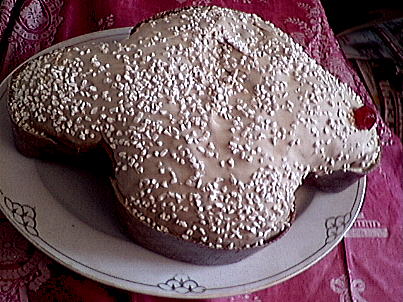
Ritual sweet cake on sale in the festivities of Easter. The dove is symbol of the Holy Spirit.
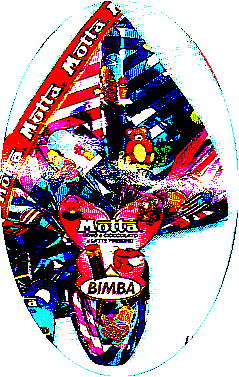
A chocolate cake, shaped as egg, containing surprises and gifts.
RITUAL ARTISTIC FOOD
I choose the term "artistic" because these products are zoomorphous or anthropomorphous, but whoever buys them for eating, does not consider them "artistic", especially since, today, the term "art" refers to works of art that are not mass - produced and of a very different intellectual engagement.
Such foods portray animals or men, representing Christian religious subjects. Their production is industrial, that is in series, and they are sold in food stores.
The types produced from the confectionery industries for the festivities are:
the DOVE, a pastry similar to the Christmas panettone, but enriched with the addition of greater quantity of eggs. It is sold for Easter. The dove in the Christian symbology represents the Holy Spirit.
The EGG of Easter is of chocolate, white or brown.
The LAMB is in marzapane (martorana pastry). It is sold at Easter. The Lamb of God is one of the first symbols of Christianity.
CHRIST RESURRECTED in paste of almonds (marzapane). Produced in Liguria. It represents the Lamb of God resurrected and triumphant over Death.
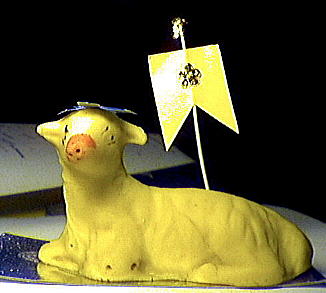
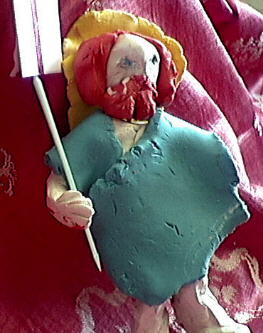
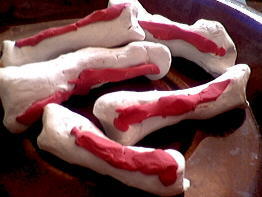
The BREASTS OF THE VIRGIN are cakes shaped as teats ("minni"), fulls with zuccata, paste of pumpkin) to the jasmin. Their production happens for the recurrence of the Dead (november,2) in Sicily.
The APOSTLE FINGERS. They are cakes with the shape of the fingers of a hand. They are fulls of paste of almonds and of cedar conserve. They are produced for the recurrence of the Dead in Calabria.
The HANDS are a bread (shaped as ring) with an only arm that joins the two hands. It is produced in Sicily for the the recurrence of the Dead, November,2.
The HEARTH. This cake is auspicious symbol of the "future rebirth of the nature". Produced for Christmas at Palma di Montichiaro, in Sicily, in almonds paste.
The FACE Of the DEFUNCT is a bread produced in some countries of the Sicily for for the the recurrence of the Dead. I believe that, spiritually, it is a kind of ritual cannibalism of great affection towards the deceased relative. Eating this bread is not unlike the Homo erectus ritual of eating the brain of the deceased relative.
PUPI AND PUPE, CAKES OF THE DEAD. They are sugar figurines, very colored, that are produced in Sicily for the feast of the dead.
THE BREAD OF THE DEAD (anthropomorphous).Still current, even if sporadic, it is prepared on November, 2. Originally it had the function of "offering food to the souls of dead relatives". These breads are anthropomorphous, are prepared in Sicily, and vary from country to country.
OXEN. It is a bread in the shape of oxen, which, coupled two by two, are decorated with engravings reproducing the symbols of the herdsmen of the area. It is produced in Modica (Ragusa). These breads are gifted to the boys, as initiatic gift of passage from the age of infancy, to the age of the work, for the new year.
BIRDS are breads shaped as birds, which are produced in Sicily for New Year's Eve.
FISH are breads shaped as fish, produced in Sicily for New Year's Eve.
HORSES For the All Saints' Day, in Val Passiria (Alto Adige. Italy), big zoomorphic breads are made, whose tradition is always religious, since eating this bread is a ritual.
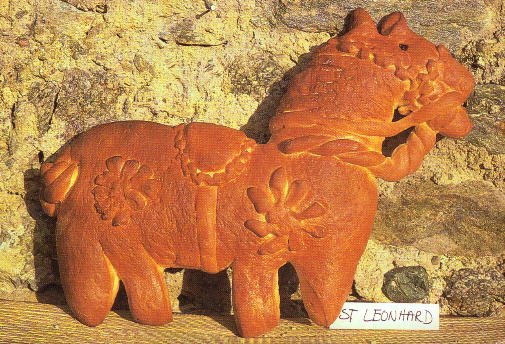
This is a bread made for the All Saints' Day celebration in St. Leomhard in Val Passiria (South Tyrol, Italy). Courtesy of Dr. Siegriid W. de Rachewiltz, director of the Agricultural Museum of Brunnemburg, Tirolo di Merano, Bolzano, Italy.
CONCLUSION
We know from Frazer that anthropomorphous cakes and breads already existed at the time of Romans; these were called "maniae", and were made in the likeness of the "god of the wood", which was celebrated every year. The "maniae" are part of a propitiation ritual for the deity.
I don't know if the Romans produced anthropomorphic cakes and breads for the recurrence of the Dead. However, it is very probable the production by Romans of cakes and breads for the dead, and also for other deities, besides the god of the wood.
About the origin of cakes and artistic ritual breads, it can be assumed that already the Greeks, before the Romans, had this use, as they had an artistic and also "confectionery" civilization of great quality.
On the origin of cakies and rituali artistic breads, it can be assumed that already the Greeks, before the Roman, had this use, in how much had an artistic civilization, and also " confectionery " of great quality.
I do not know if the Egyptians in the pyramids offered cakes and anthropomorphous or zoomorphic breads to the deceased or to the deities.
Impossible to find traces of this use in protohistoric and prehistoric civilizations, as breads and cakes are perishable.
Ritual food, which originated with Homo erectus, is not nutrient, it is a spiritual pleasure of the highest level.
This pleasure remains of the highest level when the ritual of the most varied food continues in historical civilizations; but it loses its intensity when it becomes "tradition" outside the schemes of religion.
When Homo erectus ate a piece of the brain of the chieftain or of the deceased relative, it had to be a moment of great solemnity.
T On Easter day whoever eats the "dove", eats it for "tradition", and because it is good, not to celebrate the rite of eating the Holy Spirit.
However, a ritual goes in disuse if it is not kept alive in the cult: if the Church doesn't say anymore that the dove represents the Holy Spirit, most of the people don't know it. Moreover, in the Christian tradition, the dove is symbol of the peace between God and the man (the dove that announces to Noah the end of the flood).
Of Homo erectus we have traces of a rising spirituality, even if already consolidated.
In the "ritual artistic food" of our days, we have evidence of a declining spirituality; but, nonetheless, this ritual food constitute a very important cultural and spiritual link between us and Homo erectus.
Copyright©2000-2002 by Paleolithic Art Magazine, all rights reserved.